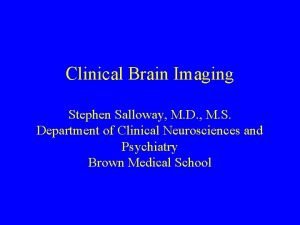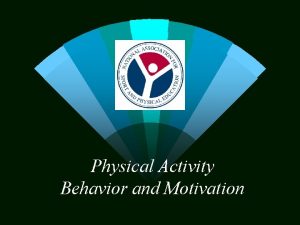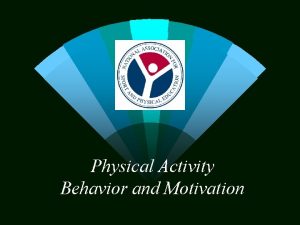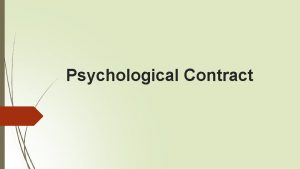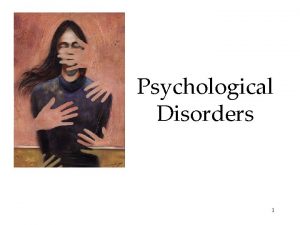Psychological Motivation for Physical Activity Daniel Joey LA















- Slides: 15

Psychological Motivation for Physical Activity Daniel, Joey, LA, Steven

Intro/Problem Statement ❏Using an integrated model of both Self-Determination Theory (SDT) & Theory of Planned Behavior (TPB) to explain and enhance athletes’ adherence to sport injury prevention. ❏This is important to us because we want to know how we can reduce the amount of injuries in sports related accidents. ❏It is important to the field because as future healthcare providers, reducing the amount of injuries is our number priority.

Background Research ❏In this article, scientists attempt to bring together variables from selfdetermination theory (SDT) and theory of planned behavior (TPB) to explain athletes’ adherence to sport injury prevention behavior. Researchers have aimed to highlight that evidence-based theoretical integration can offer a comprehensive, predictive power of psychological models and effective model to help explain sport injury prevention in a new area of research. Nevertheless, theoretical integration is not simply a mixture of psychological variables from multiple theories, rather, it is precise and evidence-based on psychological variables and mechanisms of predicting and explain health behaviors.

Extension ❏Our topic relates to other research articles like the Becoming an “Academic Coach” reading which talks about: ❏ Safer techniques when learning a sport ❏ Coaching students the right information about specific positions ❏ Knowing what you are talking about/ doing your research ❏ Contain certain research studies/ articles. ❏What was missing from our research? ❏ Ways to prevent sports injury ❏ Test to prove how sport injuries are reduced

Purpose/Hypothesis ❏The purpose of this study is to highlight evidence-based theoretical integration can offer a comprehensive and effective model to explain sport injury prevention. ❏The hypotheses of Self Determination Theory with respect to the pathways by which self-determined motivation impacts beliefs regarding future behavioural engagement, and utilizes the Theory of Planned Behavior to make the role of social cognitive mediators explicit in the relationship between self-determined motivation and intentional behaviour. ❏ Variables: Self Determination Theory (IV) & Theory of Planned Behavior (DV)

SDT & TPB Theory of Planned Behavior (TPB)

Participants ❏Several different participants took part in the study. ❏ Athletes (Recreational and Professional) ❏ Skaters (no specific type) ❏ Male Junior Netball Players ❏ Police Officers ❏No certain Demographic area. ❏No sample method was identified either.

Procedures ❏There were no procedures to the study that needed to be done. ❏The design of the research was to see the integration of SDT and TPB to see if integrating the two was helpful in preventing sports injuries ❏TPB like attitude, intentions, subjective norm and perceived behavioral control was measured to see if it helped influenced injury prevention.

Data Analysis ❏Self-determination theory and theory of planned behavior have been independently applied to predicting and understanding rehabilitation adherence. ❏Studies of recreational and professional athletes have illustrated that self determined motivation is positively correlated with adherence to home-based physiotherapy, intentions to rehab sessions and adherence to prevention of sports injuries.

Descriptive Statistics ❏In a meta-analyses the results of 37 studies integrated theories in various health related context. ❏ Exercise ❏ Dieting ❏ Breast-Feeding ❏ Condom-Use ❏Results showed that self-determined motivation from the SDT exerted significant effects on attitude, subjective norm, perceived behavioral control (PBC) and intention from TPB.

Descriptive Statistics/ Inferential Chart

Correlation Matrix Fit Vigor. PA Moderate. PA Walking Total. PA Family. SS Fit 1 Vigor. PA -0. 352167186 1 Moderate. PA -0. 501324054 0. 30303838 Walking -0. 102387156 0. 015553855 0. 495242511 1 Total. PA -0. 428051152 0. 786505601 0. 703916057 0. 587555772 1 Family. SS -0. 220392427 0. 087358673 0. 43607629 Friend. SS -0. 508478692 0. 364308211 0. 284793452 0. 134546804 0. 388300714 0. 308053129 Friend. SS 1 0. 195705625 0. 26684007 1 1

Inferential Statistics ❏The integrated model has also received preliminary support within injury prevention contexts, including elite sport and occupational context. ❏For example, a cross-sectional study on police officers revealed that the positive effect of self-determined motivation in intention for injury prevention was fully mediated by: ❏ Attitude ❏ Subjective Norm ❏ Perceived Behavioral Control (PBC) ❏The motivational effect were confirmed in a follow-up study among

Conclusions ❏The integration of multiple theoretical concepts by which the personal, social and environmental factors of athletes behavior contribute to the reduction of sport injury. ❏SDT and TPB have demonstrated effective theory-based interventions delivered by significant others, such as coaches and physiotherapists, which led to successful adherence of sport injury prevention behavior.

Implications ❏Hope to raise awareness of sport injury prevention. ❏Also to inspire integrated approaches to research with, not only having the an open mindset, but also a vision of more comprehensive understanding of athletes adherence to injury prevention behaviour.




